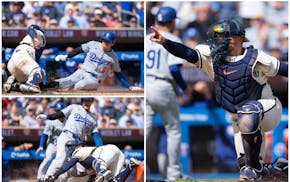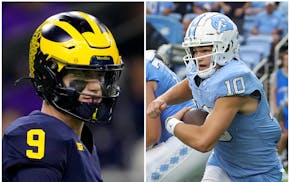Joan Gabel has held leadership positions at universities in the SEC, ACC and Big 12 conferences, so the University of Minnesota's new president wasn't dumbstruck when athletic director Mark Coyle outlined a $123 million budget to her and the Board of Regents late this week.
Gabel understands that college athletics are an expensive and highly visible industry. And as she takes over the top post at a Big Ten school, Gabel knows that her legacy will be defined in some measure by what happens on the athletic side.
"Their success, in every way that we would measure success — wins and beyond — is a proxy in many ways for the overall success of the institution," Gabel said Thursday after Coyle delivered his annual address to regents.
Coyle's presentation highlighted achievement within his department. The Gophers were the only Power Five school that posted a winning record in every team sport this school year. The department also set several school records in academic performance.
Coyle just finished his third year. He has stabilized a department racked by turmoil and instability. The Gophers are dealing with financial challenges stemming from a steep decline in attendance in revenue sports, particularly football, but overall, the department is moving in the right direction and thriving in certain areas.
Gabel will be pulled in a million directions and will hear a million opinions — as any new president at a Power Five university would — but her relationship with Coyle is imperative. Academics will and always should be Gabel's front-burner mission, but based on history, some of her most high-profile moments will involve athletics. In good times and bad. That's just reality.
It was that way with recently departed Eric Kaler, and Mark Yudof and Robert Bruininks before him.
"It's high interest to people in our state," said Bruininks, who was president during the creation of TCF Bank Stadium. "People get excited about athletics and that's one of the ways they most strongly identify with the academic programs and responsibilities of the university. I took it very seriously. I probably spent 10 to 15 percent of my time attending events, raising money for athletics, meeting with the athletic leadership."
Gabel and Coyle have met several times already, both in group settings and one on one. Both used the word "critical" in describing the importance of having alignment between university president and athletic director in vision, commitment, execution … in everything really.
The cliché is that an athletic department serves as the front porch to a university. But it's true. Nothing compares in terms of creating an emotional attachment and pride with fans and alumni. Nothing on campus is more visible than the football and basketball teams. And there's a direct correlation between a successful athletic program and financial giving by donors.
Some scoff at the hypocrisy within college sports as the industry inches closer to professionalism, and there is validity to those concerns. But this is the ballgame now. Buy-in from the top cannot be tepid.
The best example of alignment between president and AD remains Wisconsin in the late 1980s, when Donna Shalala took over as chancellor and hired Pat Richter as athletic director, which led to the hiring of Barry Alvarez as football coach and a new commitment to athletics. The rest is history.
Coyle said his initial conversations with Gabel have been "very positive." He believes her previous stops at South Carolina, Florida State and Missouri provide important background into the role and scope of athletics.
"She's been around very big programs, very successful programs," Coyle said. "Hopefully she likes what she sees here and what we've done here."
Their $123 million budget puts the Gophers at No. 8 in the Big Ten. TV revenue has changed college athletics demonstrably, but it's unclear if this represents the ceiling or what will happen when current TV contracts expire.
Gabel arrives at an interesting time. Sagging attendance remains a national concern for all sports. The Gophers are implementing new ideas aimed at enticing fans to return, especially in the three revenue-generating sports.
Gabel joked that if the athletic department is relying on her for "ticket-sale boosting techniques, we would have a pretty significant problem."
No, her leadership isn't expected at that micro level. Her role comes in the form of vision and commitment and how she handles negative incidents or tough circumstances that are inevitable. She is now caretaker of that front porch.
Chip Scoggins chip.scoggins@startribune.com
Scoggins: 'Wait one more year' can't be the Wild's plan. Thankfully, it isn't.

Scoggins: Finch feeling heat of the Suns as playoff battle looms
Scoggins: Why 'championship or bust' fits these Wolves

Scoggins: Anatomy of a game-saving play as Correa throws out Ohtani

